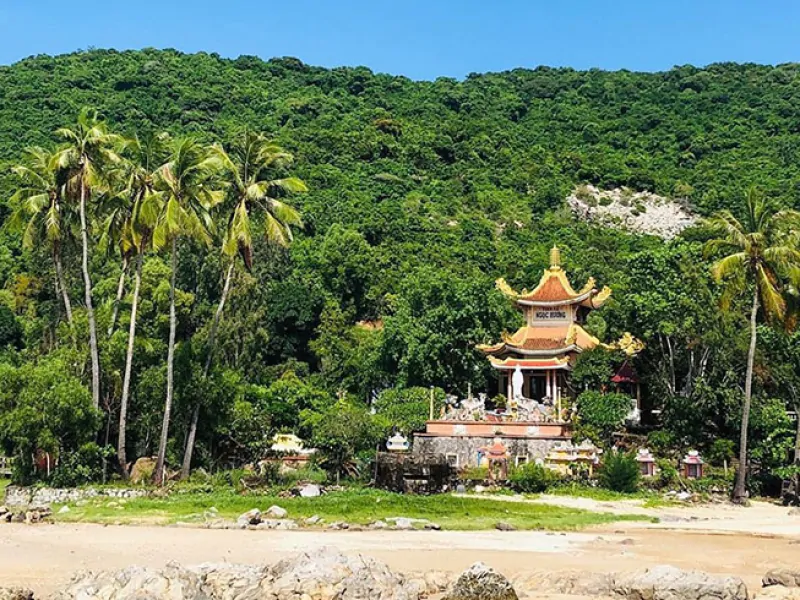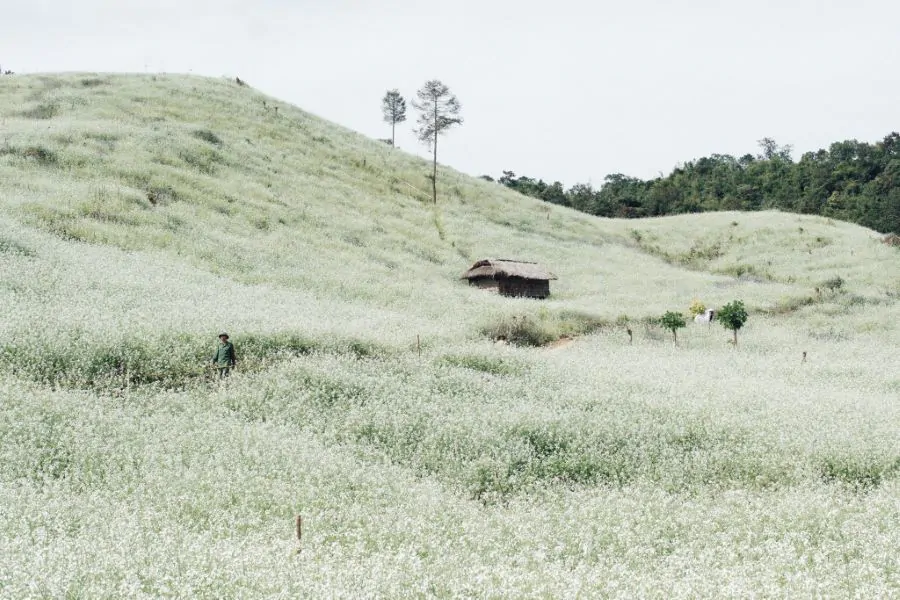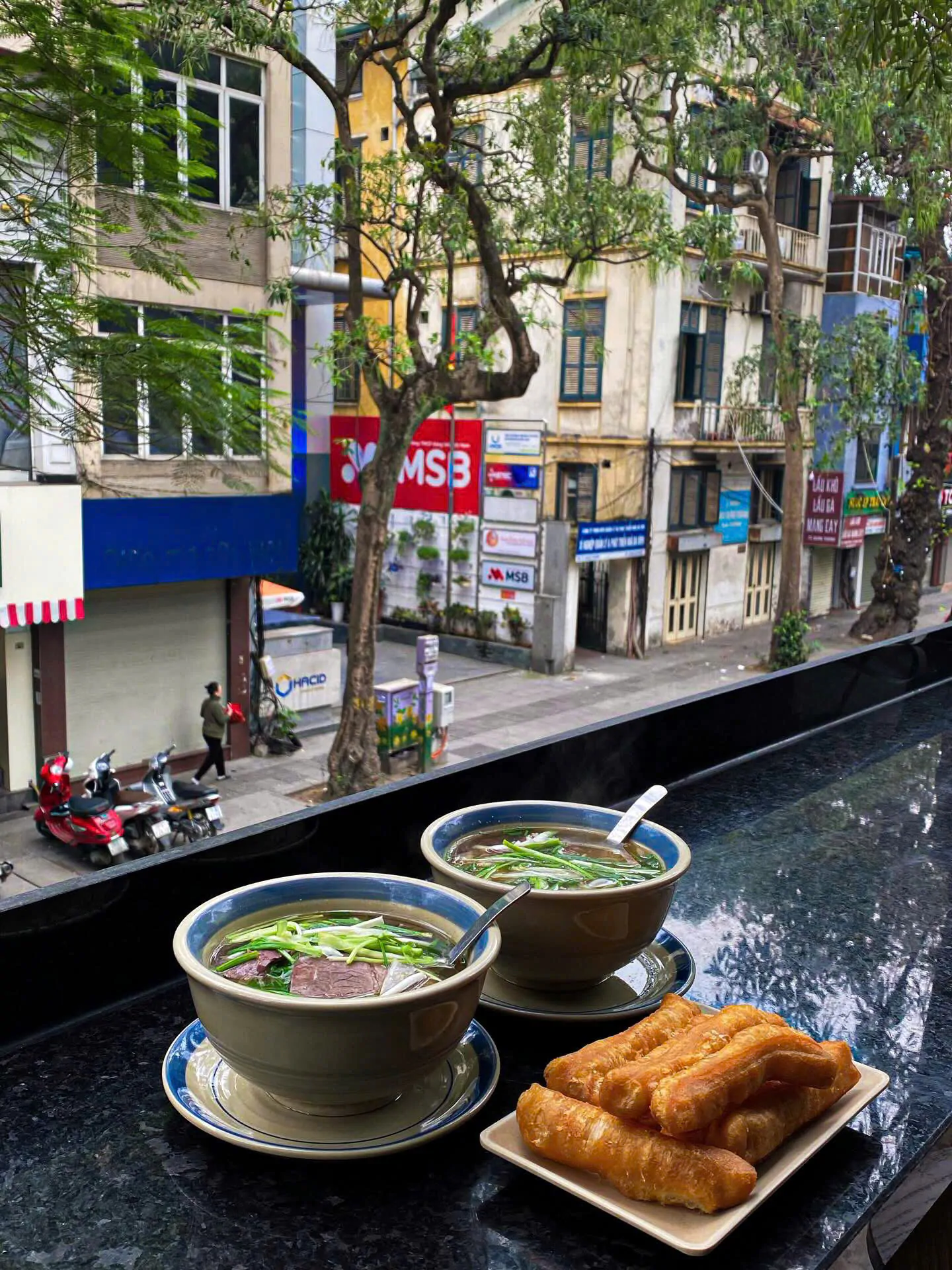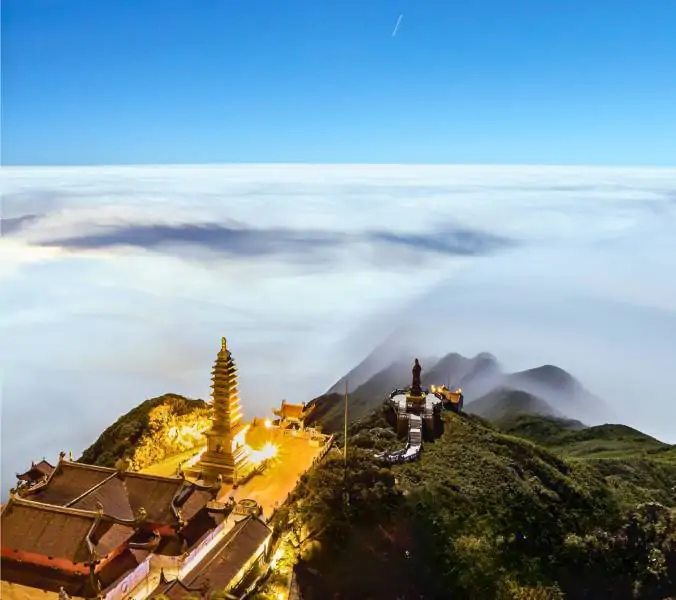Cu Lao Cham Island & Nature Reserve, Hoi An
The large island comprises 8 islets, located 20 km off the coast from Hoi An Ancient Town in Quang Binh Province. Cu Lao Cham Island boasts stunning sandy beaches, forested hills, a nature reserve, and the sea. With its untouched landscapes, the island is perfect for camping, swimming, and scuba diving, offering opportunities to marvel at the coral reefs and exquisite marine life.
Location: Tan Hiep, Hoi An, Quang Nam Province
I. History of Cu Lao Cham Islands

Cham Islands hold a significant historical and cultural heritage, believed to be the initial landing site of the Cham people when they migrated from Indonesia to Quang Nam Province. Evidence of their presence includes small monuments, dikes, and rice-growing basins hidden within the island’s forests, as well as 17th-century pagodas and temples found in the villages.
Throughout its history, the island served as a vital port for the Champa Kingdom, and it was deeply integrated into the international trading network, particularly through its connection with Hoi An. Hoi An itself was a bustling hub for international vessels and junks from the 15th century until the early 20th century.
Archaeological findings suggest that Cu Lao Cham was initially settled 3,000 years ago, with the establishment of trade relations with other countries dating back around 1,000 years. Many architectural treasures from the 18th to 20th centuries still stand on the island, including the shrine dedicated to Than Yen Sao, constructed in 1843 at Bai Huong, and Hai Tang Pagoda, built in 1753 on the western hillside of Hon Lao.
Beyond its historical significance, Cu Lao Cham offers more attractions for visitors. One notable site is the famed Well of the Cham people, accessible after a three-hour canoe trip, adding to the island’s allure as a destination rich in both natural beauty and cultural heritage.
II. Topography of Cu Lao Cham Nature Reserve

Cu Lao Cham Island’s topography is characterized by two main peaks: a 517m peak located in the center of the island and a 326m peak situated at the western end. Natural forest covers a significant portion of the island, with 532 hectares designated as a nature reserve, constituting about 35% of the total area, while plantation forest extends over an additional 30 hectares.
The Cham island archipelago consists of one large island and seven smaller islands: Hon Dai, Hon Lao, Hon Kho Me, Hon La, Hon Kho Con, Hon Ong, Hon Tai, and Hon Mo. The largest among them is Hon Lao, spanning 1,317 hectares and featuring a circular shape with a peak height of 500m. Notably, Bim and Ong beaches on Hon Lao offer picturesque sandy stretches and rock reefs, perfect for swimming and photography.
Here’s a brief overview of some of the notable beaches on the island:
- Bai Bim: Known for its beautiful beaches and rock reefs, offering opportunities for swimming and photography.
- Bai Ong: Features a white sandy stretch with clear water and a stunning view, along with numerous restaurants serving local specialties and various entertainment services for tourists.
- Bai Lang: A bustling area with a high population, offering insights into local life and culture, including attractions related to the Champa Kingdom.
- Bai Bac: A peaceful and secluded northern beach, currently undeveloped but potentially earmarked for future resorts and villas.
- Bai Xep: Renowned for its pristine beauty and colorful coral reefs, making it an ideal spot for swimming and snorkeling.
- Bai Chong: Boasts longer stretches of beach than Bai Ong, with beautiful rock reefs and a bridge for photography, along with calm waters suitable for swimming.
- Bai Huong: Known for its delicious seafood, bustling with ships and boats docking, although not recommended for swimming due to its industrial activity.
These beaches collectively offer diverse experiences, from relaxation and exploration to cultural immersion and culinary delights, making Cu Lao Cham Island a captivating destination for visitors.
III. Biodiversity Values

Cu Lao Cham Island serves as a sanctuary for valuable swallow birds, providing shelter for their nests. The natural vegetation on the island comprises lowland evergreen forests, rich in diverse woods and home to rare animal species.
Among the notable wildlife are macaques, monitor lizards, and pythons, contributing to the island’s ecological diversity. The Cu Lao Cham nature reserve hosts an impressive array of vascular plant species, with 265 reported to date. Additionally, a species of swiftlet is known to nest on Hon Kho within the reserve.
The island is renowned for being home to salanganes, whose nests have long been coveted as a delicacy among aristocrats and the affluent, commanding high prices in the market. Tourists visiting on a clear day can witness the cliffs where these birds build their nests and interact with those who harvest the nests.
Surrounding the island, vibrant coral reefs thrive underwater, adding to the island’s allure for snorkelers and divers. Despite being situated in a saline environment, a remarkable square-bottom well on the island consistently provides clear freshwater throughout the year.
Visitors to Cu Lao Cham have the opportunity to marvel at the sea swallows’ nests clinging to the towering cliffs and indulge in the island’s renowned seafood delicacies, including octopuses, lobsters, abalone, and more. Moreover, the island offers an array of fascinating souvenirs such as pearls, conchs, and tortoise shells, allowing visitors to take a piece of its natural beauty home with them.
IV. What to See in Cu Lao Cham Nature Reserve?

1. Hai Tang Pagoda

The Hai Tang Pagoda, constructed in 1758, is dedicated to the worship of Bodhisattva, Buddha, the sea god, and local deities. Over time, the pagoda faced the ravages of a storm, prompting local residents to undertake its reconstruction and redecoration in 1848. As a result, the pagoda now stands approximately 200 meters away from its original location.
Situated at the foot of the west mountain of Hon Lao Island, Hai Tang Pagoda overlooks a small valley on Cham Island. The name “Hai Tang” is derived from “Hai,” meaning the sea, and “Tang,” referring to the Tipitaka, the Buddhist holy scriptures containing the words of Buddha. This name reflects the pagoda’s reverence for the sea and its connection to Buddhist teachings.
Location: Hon Lao Island, Cham Island
2. Cham people’s Ancient Well
The well you described, dug by the Cham people two hundred years ago, stands as a testament to their ingenuity and craftsmanship. Despite its age, the well continues to provide fresh water to the local community, remaining functional and reliable throughout the years. Its architectural design, characteristic of Cham wells, features a pipe shape, annular brick construction, a square pillar, and a surrounding square base, showcasing the traditional techniques employed by the Cham people.
Remarkably, even during the dry season, when water sources may dwindle, this well remains a valuable resource for the locals, supplying water for various purposes. Its enduring functionality speaks to the resilience and enduring legacy of the Cham people’s engineering prowess and their deep connection to the land and its resources.
Location: Xom Cam Village, Cham Island
3. Temple of Bird’s Nest Business Founders

The temple you mentioned, erected in the early 19th century, serves as a place of worship for the founders of the bird’s nest business, as well as the sea gods, mirroring the practices observed at the Hai Tang Pagoda. Each year, in accordance with the Chinese calendar, local residents gather at the temple on the 9th and 10th of March to offer prayers for a prosperous new year and bountiful harvests. This tradition reflects the deep spiritual connection of the local community to their cultural heritage and the natural environment, seeking blessings for abundance and prosperity in the coming year.
Location: Huong Beach, Cham Island
4. Cham Island Marine Museum
The museum you described offers visitors a comprehensive insight into the history, traditions, customs, and festivals of the Cham people, providing a rich understanding of their cultural heritage. Additionally, visitors have the opportunity to learn about the fascinating sea creatures that inhabit the waters surrounding the island. Beyond cultural and natural history, the museum also sheds light on the lifestyle of the island’s residents, offering glimpses into their daily routines, traditions, and way of life. This immersive experience allows visitors to gain a deeper appreciation for the unique heritage and environment of Cu Lao Cham Island.
5. Tan Hiep Market
The local market you mentioned serves as an ideal destination for purchasing seafood and souvenirs on Cu Lao Cham Island. One of the most sought-after items by tourists is half-dried cuttlefish, renowned for its freshness and affordability. The market offers an array of seafood options, all sourced locally and available at attractive prices. In addition to seafood, visitors can also find a variety of souvenirs, allowing them to take home mementos of their visit to the island. This bustling market provides a vibrant atmosphere where visitors can immerse themselves in the local culture while indulging in delicious seafood and finding unique treasures to cherish.
Location: Cham Island Pier
V. What to Do in Cu Lao Cham Island?

1. Camping
Cham Island offers an exceptional setting for camping enthusiasts, with its diverse natural landscapes and pristine environment. Bai Xep and Bai Bim stand out as ideal camping spots, characterized by their untamed beauty and spacious surroundings, perfect for those seeking a wilderness experience. Alternatively, Bai Huong and Bai Ong provide convenient options for camping, as local residents offer necessary camping tools and amenities to ensure a comfortable outdoor stay. Regardless of the chosen location, proper preparation is key to a successful camping trip, ensuring that you have all the essentials needed for a memorable experience amidst the stunning natural surroundings of Cham Island.
2. Sea trekking

The new underwater walking experience sounds absolutely thrilling! It’s amazing to think that with just a functional hat, people can immerse themselves in the underwater world and explore the marine life and coral reefs up close. This activity offers a unique and accessible way for people of all ages, including those as young as 80, to enjoy the beauty of the sea in a safe and comfortable manner. Walking among schools of fish and vibrant coral reefs must be an unforgettable experience, providing a sense of wonder and connection with the marine environment. It’s truly an opportunity to create cherished memories and appreciate the incredible diversity of life beneath the waves.
3. Snorkeling
Snorkeling is indeed another fantastic way to experience the beauty of the sea, allowing you to observe marine life and coral reefs up close. With the convenience of a guided tour and full equipment provided, snorkeling becomes accessible to all, offering an unforgettable adventure at a reasonable price of around 200,000 VND.
However, it’s essential to snorkel responsibly and prioritize the protection of the sea’s biodiversity. This means respecting the marine environment, avoiding touching or disturbing coral reefs and marine life, and refraining from leaving any waste behind. By practicing responsible snorkeling, we can help preserve the delicate ecosystems of the sea for future generations to enjoy.
4. Swimming
Cu Lao Cham’s abundance of beautiful beaches offers ideal conditions for swimming and enjoyment. With widths typically around 20 meters and lengths ranging from 100 to 300 meters, these beaches provide ample space for relaxation and recreation. The gentle waves and clear, cool waters enhance the swimming experience, creating a refreshing and inviting environment for visitors of all ages. Whether you’re seeking a leisurely dip or a day of aquatic adventure, Cu Lao Cham’s pristine beaches promise plenty of fun and unforgettable moments by the sea.
VI. Best Time to Visit Cu Lao Cham Archipelago
The tropical monsoon climate significantly influences the weather on Cu Lao Cham Island. For the best experience, it’s recommended to visit between March and August. During these months, the weather tends to be sunny, and the water conditions are excellent, making it an ideal time for various activities.
However, in the remaining months, heavy rain and occasional big storms can occur, which may affect travel plans and outdoor activities. For those interested in snorkeling or diving, June, July, and August are particularly favorable, as these months offer optimal conditions for underwater exploration. During this time, numerous tour companies and dive centers provide trips and excursions, allowing visitors to fully enjoy the island’s marine wonders.
Check out the seawater temperature in Cham Islands in months of the year in the table below:
| Month | Avg. Temp. | Warmest Temp. | Coldest Temp. | Ideal Activity? |
| January | 23.1°C/73.6°F | 26°C/78.8°F | 21°C/69.8°F | x |
| February | 22.8°C/73°F | 25.1°C/77.2°F | 20°C/68°F | x |
| March | 23.7°C/74.7°F | 26.4°C/79.5°F | 21°C/69.8°F | x |
| April | 24.8°C/76.6°F | 27.1°C/80.8°F | 22°C/71.6°F | x |
| May | 26.9°C/80.4°F | 29°C/84.2°F | 25°C/77°F | x |
| June | 28.4°C/83.1°F | 30°C/86°F | 26°C/78.8°F | x |
| July | 28.9°C/84°F | 31°C/87.8°F | 27°C/80.6°F | x |
| August | 29.4°C/84.9°F | 31°C/87.8°F | 28°C/82.4°F | x |
| September | 29.2°C/84.6°F | 30.9°C/87.6°F | 27°C/80.6°F | x |
| October | 27.8°C/82°F | 30°C/86°F | 26°C/78.8°F | x |
| November | 26.3°C/79.3°F | 28.3°C/82.9°F | 24.6°C/76.3°F | x |
| December | 24.6°C/76.3°F | 27°C/80.6°F | 22°C/71.6°F | x |
VII. Where to Stay in Cham Islands?
On Cu Lao Cham, you won’t find any five-star hotels or resorts; instead, you’ll discover a charming array of homestays and hostels. Despite the absence of luxury accommodations, you needn’t worry, as the service provided here is top-notch, and the prices are budget-friendly. Here are some recommended accommodations for your stay:
- Homestays: Immerse yourself in the local culture by opting for a homestay experience. You’ll have the chance to stay with welcoming local families who offer comfortable lodging, delicious home-cooked meals, and insights into island life.
- Hostels: Perfect for budget travelers, hostels on Cu Lao Cham provide affordable dormitory-style accommodation with shared facilities. Additionally, many hostels offer a social atmosphere, making it easy to meet fellow travelers and share experiences.
While you won’t find lavish resorts, Cu Lao Cham’s homestays and hostels offer a unique opportunity to connect with the island’s culture and community. With their excellent service and reasonable prices, you’re sure to have a memorable and enjoyable stay on this picturesque island.
1. Tam Hien’s Homestay
Location: Bai Ong Beach, Cham Island
Tel: 0120 618 3516
2. Hiep’s Homestay
Location: Huong Beach, Cham Island
Tel: 0986 651 448
3. Thu Trang’s Homestay
Location: Lang Beach, Cham Island
Tel: 0985 237 941
VIII. How to Get to Cu Lao Cham Islands?
To reach Cu Lao Cham, you’ll first need to travel to Hoi An or Da Nang. Both cities are accessible via numerous flights from major cities like Hanoi and Ho Chi Minh City. Once you arrive in Hoi An or Da Nang, you’ll have several transportation options to reach Cham Island:
- Speedboat: Speedboats depart regularly from Cua Dai Beach in Hoi An and the Bach Dang Wharf in Da Nang, offering a fast and convenient way to reach Cham Island. The journey takes approximately 30 to 45 minutes, depending on the departure point and sea conditions.-
- Public Ferry: Another option is to take the public ferry from Cua Dai Beach in Hoi An. The ferry ride to Cham Island typically takes around 1 to 1.5 hours, offering a more budget-friendly alternative to speedboats.
- Private Boat Tours: For a more personalized experience, you can arrange a private boat tour from Hoi An or Da Nang. This option allows you to customize your itinerary and explore other nearby attractions along the way.
Regardless of which transportation option you choose, traveling to Cham Island promises to be an exciting adventure, with stunning coastal views and the promise of a memorable island getaway awaiting you upon arrival.
When planning a trip to Cu Lao Cham Island, aside from Cu Lao Cham Island, you should consider visiting other fantastic destinations such as Hoi An Old Town, An Bang Beach, My Son Holy Land , Japanese Covered Bridge , Quan Cong Temple , Assembly Hall of the Fujian Chinese Congregation, Quan Thang Ancient House , Tan Ky Old House, Countryside Sites, Cam Thanh Village etc.. These places offer diverse experiences, ranging from pristine beaches and bustling cities to charming historical sites and enchanting landscapes.
To ensure the best vacation experience in Vietnam, it’s important to plan and book in advance. Among the many tour companies offering services in Vietnam, Discover Vietnam Tours is a great option for arranging your travel itinerary with just a few emails and WhatsApp messages. They provide airport transfers, accommodation booking, tour guides, drivers, and customizable activities based on your preferences.
With their assistance, you can tailor your trip according to your desired schedule and preferences, ensuring a seamless and enjoyable travel experience throughout Vietnam.

























